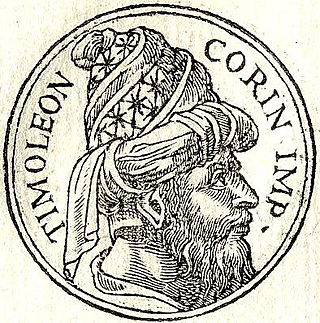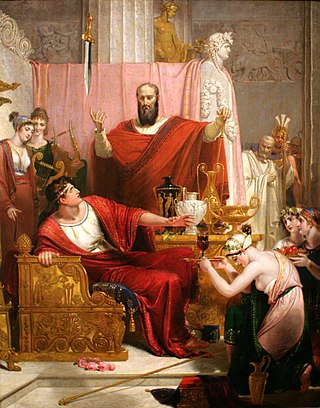Plot
Involved from early childhood in the theatre, the Athenian-born Nikeratos grows into a successful actor through his performances in tragedies. During his formative period, he meets the philosopher Plato and Dion, a respected politician from Syracuse and brother-in-law to the city's tyrannical ruler Dionysios the Elder. As Archon Dioysios rules harshly from the island fortress of Ortygia, through a powerful force of mercenaries of diverse origins. He does however provide effective protection for the citizens of Syracuse from the threat of Carthage.
Nikeratos frequents Plato's Academy and grows to appreciate his wisdom, though he also discerns that Plato and Dion are somewhat more idealistic than practical in their views on humanity and government.
Nikeratos sails for Syracuse as a member of a theatre troupe, but upon arrival receives the news that Dionysios, their patron, has just died. Nikeratos chooses to remain in Syracuse despite the dangerous political climate, and meets and makes a favourable impression upon the city's new ruler, Dionysios the Younger. While Dionysios is not the brutal tyrant his father was, he is dissolute and politically inept, and Dion invites Plato to serve as a teacher to Dionysios; the two hope to mould him into a philosopher-king ruling according to Platonic ideals.
While Dionysios wants Plato's approval, he makes only half-hearted efforts to reform either his own luxurious lifestyle or the Syracusan government. Part of this is due to his own nature, but other factors also inhibit reform, such as Syracuse's large and oppressive mercenary force, who are necessary to counter Carthaginian aggression, and the Syracusan people themselves, who have become politically enfeebled under Dionysios the Elder's long rule. Dion is eventually exiled due to the machinations of his rival Philistos, a loyal but corrupt supporter of Dionysios.
During these years Nikeratos enjoys a prosperous and successful career acting in Syracuse and mainland Greece. He becomes a lifelong friend and mentor to a promising young actor named Thettalos while keeping informed about events in Syracuse and Plato's life there.
After Dionysios confiscates Dion's estates and gives his wife to another man, Dion returns with an army and captures most of Syracuse while Dionysios' loyalists hold out in the island citadel of Ortygia. In the ensuing fighting Syracuse is brutally ravaged before Dion gains the upper hand. Philistos is killed by the vengeful citizenry and Dionysios flees to live out his remaining years in exile. Dion is initially welcomed as a liberator by the Syracusans, but his attempts at reform prove unpopular and he is eventually assassinated. He is succeeded by Callippus, an ambitious and unscrupulous pupil of Plato.
In the novel's final chapter, a dozen years after Dion's downfall, Nikeratos encounters the young Alexander the Great and wistfully regrets that Plato never had the chance to tutor Alexander, who might have pursued Plato's social ideals with far greater success than Dionysios the Younger did.

Syracuse is a historic city on the Italian island of Sicily, the capital of the Italian province of Syracuse. The city is notable for its rich Greek and Roman history, culture, amphitheatres, architecture, and as the birthplace and home of the pre-eminent mathematician and engineer Archimedes. This 2,700-year-old city played a key role in ancient times, when it was one of the major powers of the Mediterranean world. Syracuse is located in the southeast corner of the island of Sicily, next to the Gulf of Syracuse beside the Ionian Sea. It is situated in a drastic rise of land with 2,000 metres (6,600 ft) depths being close to the city offshore although the city itself is generally not so hilly in comparison.
The 4th century BC started the first day of 400 BC and ended the last day of 301 BC. It is considered part of the Classical era, epoch, or historical period.
This article concerns the period 349 BC – 340 BC.
This article concerns the period 389 BC – 380 BC.
This article concerns the period 369 BC – 360 BC
This article concerns the period 359 BC – 350 BC.

Timoleon, son of Timodemus, of Corinth was a Greek statesman and general.

Dionysius I or Dionysius the Elder was a Greek tyrant of Syracuse, in Sicily. He conquered several cities in Sicily and southern Italy, opposed Carthage's influence in Sicily and made Syracuse the most powerful of the Western Greek colonies. He was regarded by the ancients as an example of the worst kind of despot—cruel, suspicious and vindictive.
The philosopher king is a hypothetical ruler in whom political skill is combined with philosophical knowledge. The concept of a city-state ruled by philosophers is first explored in Plato's Republic, written around 375 BC. Plato argued that the ideal state – one which ensured the maximum possible happiness for all its citizens – could only be brought into being by a ruler possessed of absolute knowledge, obtained through philosophical study. From the Middle Ages onwards, Islamic and Jewish authors expanded on the theory, adapting it to suit their own conceptions of the perfect ruler.

Dionysius the Younger, or Dionysius II, was a Greek politician who ruled Syracuse, Sicily from 367 BC to 357 BC and again from 346 BC to 344 BC.

Hermocrates was an ancient Syracusan general during the Athenians' Sicilian Expedition in the midst of the Peloponnesian War. He is also remembered as a character in the Timaeus and Critias dialogues of Plato.

The Seventh Letter of Plato is an epistle that tradition has ascribed to Plato. It is by far the longest of the epistles of Plato and gives an autobiographical account of his activities in Sicily as part of the intrigues between Dion and Dionysius of Syracuse for the tyranny of Syracuse. It also contains an extended philosophical interlude concerning the possibility of writing true philosophical works and the theory of forms. Assuming that the letter is authentic, it was written after Dion was assassinated by Calippus in 353 BC and before the latter was in turn overthrown a year later.
The Epistles of Plato are a series of thirteen letters traditionally included in the Platonic corpus. With the exception of the Seventh Letter, they are generally considered to be forgeries, although many scholars even reject the seventh.They were "generally accepted as genuine until modern times"; but by the close of the nineteenth century, many philologists believed that none of the letters were actually written by Plato.
Callippus was a tyrant of Syracuse who ruled briefly for thirteen months from 354 to 352 BC. He was a native Athenian, who traveled with Dion to Sicily to capture Syracuse, where Dion became the tyrant. Callippus then gained power by assassinating Dion, but ruled briefly before being ousted from power himself. Afterwards he commanded a band of mercenaries, who later killed him with the same sword that he used to kill Dion.
Plato was an ancient Greek philosopher, the second of the trio of ancient Greeks including Socrates and Aristotle said to have laid the philosophical foundations of Western culture.
Hicetas was a Syracusan general and tyrant of Leontini, contemporary with the younger Dionysius and Timoleon.
Dion, tyrant of Syracuse in Sicily, was the son of Hipparinus, and brother-in-law of Dionysius I of Syracuse. A disciple of Plato, he became Dionysius I's most trusted minister and adviser. However, his great wealth, his belief in Platonism and his ambition aroused the suspicions of Dionysius I's son and successor, Dionysius II. An indiscreet letter from Dion to the Carthaginians led to his banishment. Settling in Athens, he lived a prosperous life until Dionysius II dispossessed him of his estates and income. Landing in Sicily in 357 BC, he was successful in conquering Syracuse. However, Dion soon quarrelled with the radical leader Heraclides and was forced into exile. Recalled in 355 BC, he became master of the whole city but his imperious behaviour and financial demands on the people of Syracuse soon alienated the population. His supporters abandoned him and he was assassinated. His attempts to liberate Sicily only brought political and social chaos to the island which would last for nearly 20 years.

The siege of Syracuse from 344 to 343/342 BC was part of a war between the Syracusan general Hicetas and the tyrant of Syracuse, Dionysius II. The conflict became more complex when Carthage and Corinth became involved. The Carthaginians had made an alliance with Hicetas to expand their power in Sicily. Somewhat later, the Corinthian general Timoleon arrived in Sicily to restore democracy to Syracuse. With the assistance of several other Sicilian Greek cities, Timoleon emerged victorious and reinstated a democratic regime in Syracuse. The siege is described by the ancient historians Diodorus Siculus and Plutarch, but there are important differences in their accounts.
Heracleides was a Syracusan who held the chief command of the mercenary forces under Dionysius II of Syracuse.
The history of Greek and Hellenistic Sicily began with the foundation of the first colonies around the mid 8th century BC. The Greeks of Sicily were known as Siceliotes.





